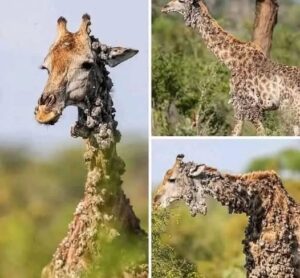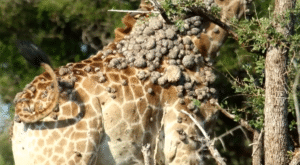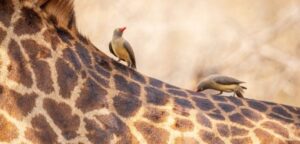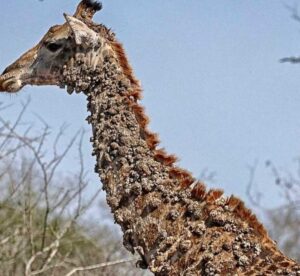Photographer Captures Breathtaking Giraffe — Then Uncovers a Hidden Struggle

While many couples celebrate 40 years of marriage with exotic vacations or luxury cruises, Marius and Michelle Nortje chose something far more personal — a journey into the heart of South Africa’s Kruger National Park. For them, no destination could compare to the raw beauty of the wild.
What they didn’t expect was to witness — and document — something that would capture global attention.
“We’ve been to the park multiple times a year,” Marius told The Citizen. As a seasoned wildlife photographer, he thought he had seen it all. But on this particular trip in December, during a quiet drive along a gravel road, the unexpected happened.
First, two giraffes appeared from the bush. Then a third emerged — and it immediately stopped Marius in his tracks.

“I noticed unusual growths all over her body,” he recalled. Without hesitation, he lifted his camera and began snapping photos. The giraffe looked calm, peacefully grazing, yet the sight was alarming.
The images, once shared on Facebook, quickly went viral. Viewers were captivated — and deeply concerned. “People were asking if she was suffering,” Marius said. “She didn’t seem distressed, but those lumps looked painful.”
Hoping for answers, he tagged South African National Parks (SANParks), though no response had been received at the time of the report.
A Rare Condition Unveiled
Soon after, animal welfare group WorldWide Vets picked up the story. According to Dr. Gemna Campling, the organization’s founder, the giraffe’s unusual appearance was due to a rare viral infection — papillomavirus, more specifically, a strain believed to be Bovine Papillomavirus (BPV).
“This virus typically affects cattle, but it appears it can sometimes impact giraffes,” Dr. Campling explained. “Transmission likely occurred through direct contact — perhaps spread by oxpecker birds that feed on parasites.”
Oxpeckers, common in the region, land on large mammals and may unintentionally spread viruses through minor wounds or abrasions. Interestingly, none of the other giraffes in the small group showed symptoms.

Although the lumps appear severe, the condition isn’t fatal.
“Most cases resolve on their own,” said Dr. Campling. “There’s no treatment for BPV in giraffes, but wildlife veterinarians monitor these cases closely. Fortunately, this virus doesn’t pose a risk to humans.”
Still, she acknowledged the visible discomfort the giraffe may be experiencing. “While not life-threatening, the lesions can become large enough to interfere with movement or feeding. It’s certainly not pain-free at that stage.”
Beauty, Resilience, and the Fragility of Nature
Even with the disturbing sight, the giraffe continued to graze peacefully — a quiet testament to the resilience of wild animals. Her calm demeanor touched thousands of hearts online, with many expressing empathy, awe, and a newfound curiosity about wildlife diseases.
For Marius and Michelle, it was a bittersweet reminder of nature’s beauty — and its challenges.

“We go back to the bush because it grounds us,” Marius said. “This moment, though heartbreaking, reminded us why we keep returning. Every trip is unpredictable. And sometimes, the most powerful stories are the ones you didn’t plan to tell.”